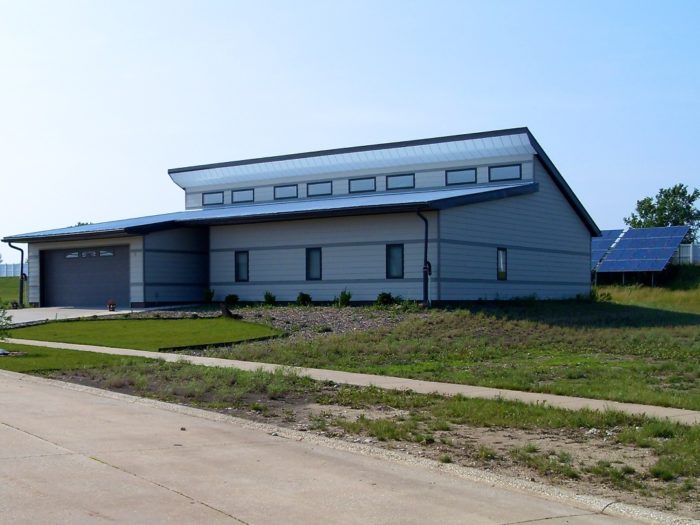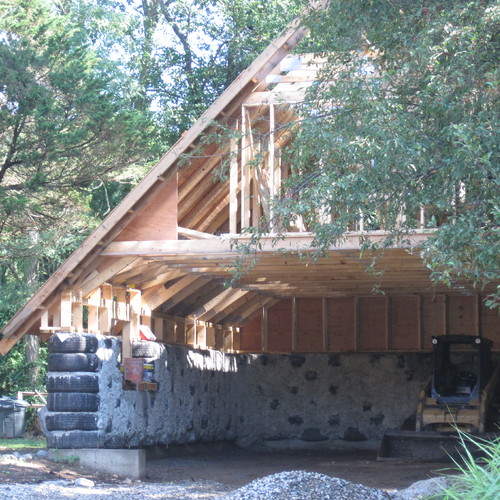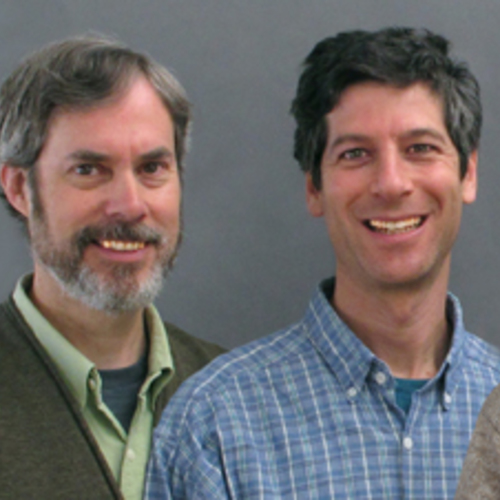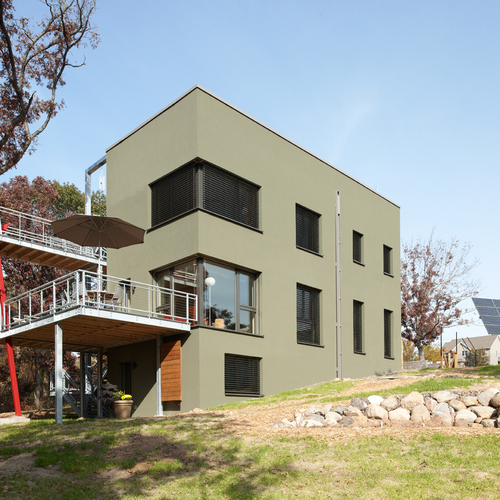
Equinox House
This all-solar, net-zero energy house in Urbana, Illinois, is the subject of a blog by the same name by Ty Newell, a professor emeritus at the University of Illinois Newell's solar energy credentials stretch back to the 1970s.Image Credit: Ty Newell
You might call Ty Newell the reluctant engineer. At the University of Michigan in the early 1970s, he would rather have studied natural resources or liberal arts, but those programs were full. So he went into engineering, figuring he’d switch to one of his first choices in a semester or so.
Except that it never happened. His grade point average wasn’t high enough to get him into natural resources, and the prospect of being drafted for duty in Vietnam kept him from dropping out of school. So engineering it was going to be.
Out of school in 1974, Newell worked for a couple of years in an Ohio plastics plant as a project engineer, and then something weird happened. “Of all the unexpected things,” Newell says, “I found I thoroughly enjoyed engineering and I found that it would give me the tools and background to work in the alternative energy field in a manner I would enjoy.”
Newell decided he needed more than an undergraduate degree, so he took courses at Ohio State University, where he ran into Michael Moran, a professor who taught a dreaded course in thermodynamics. He once received a zero on a test in Moran’s class, but he discovered that he not only had an instinctive understanding of the material, he also liked it.
That realization helped propel him into solar energy engineering, first at the University of Utah, where he landed a teaching assistant’s job as he pursued a master’s degree, and eventually to the engineering faculty at the University of Illinois at Champaign-Urbana.
Newell builds a superinsulated passive solar home
Newell tells this story as part of his blog called Equinox House, his account of building a superinsulated, solar home for himself and his wife in Urbana, Illinois.
The blog is a step-by-step tale of how the house was built, starting with the insulated concrete form (ICF) foundation and solar panel installation in the fall of 2009 to a successful Thanksgiving gathering in the new house in 2010.
Construction entries are light on the verbiage, relying instead on hundreds of photographs and caption-like comments on each stage of construction. I started at the beginning and about given up on finding any running commentary on the whys and wherefores of the project or much about its author when I stumbled across an entry from January 29, 2010 in which Newell lays out the groundwork for the project in a “preface” to the Equinox project.
Bingo.
While the construction blog is in itself excellent in its detail, the site also features valuable information on a variety of related topics, such as the economics of a 100% solar home, components (such as windows and walls), rainwater collection, and actual energy performance. Although construction is over, data collection and evaluation goes on. It’s an exceptionally well-documented project. The self-effacing storytelling in Newell’s preface helps pull it all together. He’s a much more engaging writer than he gives himself credit for.
For anyone planning on going the solar, net-zero route, or just learning what it’s all about, the blog will prove a goldmine.
Here are some excerpts.
On his blog’s point of view
“I plan to target these writings to the general public, but that doesn’t mean things will be interesting, clearly organized, or grammatically correct. Remember, I am an engineer. My lectures as a professor have been known to lower the metabolism of my students to dangerously low levels (which at least conserves energy), and I’m sure my written stuff is just as dull. I wish I could write with the scientific clarity of Edward Thorndike, the logic of Amory Lovins, and the conviction of Aldo Leopold, but unfortunately those are not skills I’m endowed with (see…I even ended my sentence with a preposition, something my English major/Librarian spouse, Deb, will be quite upset at…..she doesn’t like sentences that end in ‘at,’ either).”
On why he built Equinox House
“We must return to living on our daily allowance of solar energy. Without significant efforts taken now to develop a sustainable way of life, our future generations will be faced with more war, famine and pestilence in order to make adjustments to survive in a world with diminished resources, overpopulation, and massive pollution. Leaving our children, their children, and beyond with to cope such hardships is something I find hard to live with.
“So, the above is a bit gloomy, and I’m not by nature a gloomy, pessimistic person. If I were, I wouldn’t put in the effort to work toward the changes we need to achieve sustainable lifestyles. So here’s the optimistic side of things. I know that we can do more with less now. That is, I see the world as one that has plenty of resources for improving the quality of life for all people. Improving one’s life does not have to be at the expense of others.”
“When I began working in alternative energy in the 1970s, we were still developing the required technologies. Today, because of the hard work of a lot of stubborn people like many of my faculty colleagues and industry friends, enabling technologies are available now at a cost that is affordable.”
On the rebirth of interest in solar
“Various student groups have always invited me to talk about solar energy, but from 1985 to 2000, my audience ranged between 1 to 4 people. As small as these audiences might be, and some really were only 1 or 2 people, if they are the right 1 or 2 people, they might be the ones who accomplish significant things.
“Around 2002, as I went to give a talk on solar to a student group, I entered the room and saw an overflowing crowd of people. I was sure it was the wrong room location. But it wasn’t, and since that time, the audiences have been consistently full as our youth recognize the failure of older generations to address the problems that they will be facing. Will we rise to the challenge this time, or will we fade as before as the most recent energy price shocks become a distant memory?”
On the beauty of the design
“Equinox House is one of the most technologically advanced homes ever built. But if you visit Equinox House, you will not see the complexity nor be aware of it. You will experience a simple house that exists to serve its occupants and keep them comfortable. The complexity of its engineering design and Equinox House’s embedded technology, paradoxically makes it a very simple home to live in.
“Today’s automobiles are similar with their highly sophisticated technologies. And yet, today’s cars are simpler and safer to drive, with repairs and maintenance less frequent than ever before. Equinox House has incorporated sensing and control technologies that simplify living in the house. Even with a failure of the local utility, its robust design ensures that water pipes will never freeze, and that it will be a comfortable shelter in either summer or winter. And, because it is a true, net zero home that is 100% powered by solar energy, future increases in utility rates will not be a concern.”
On the paradox of windows
“Equinox House is a modestly windowed home. At the same time, the windows have been designed to brightly light the interior throughout the year, and efficiently provide solar heating in the winter. The house is named after its novel ‘equinox overhang’ that protects the clerestory windows from the summer sun while acting as a solar radiation reflector during the winter.
“Windows are generally misunderstood and poorly incorporated into building design. Very few people are able to provide quantitative information on the cost and value of a window. Sales personnel are unable to supply answers, and are most interested in selling you as many windows as possible.
“In almost all cases, windows do not save money. They are the most expensive part of the house exterior and require the most maintenance. The most ‘economical’ house would be a Styrofoam igloo. So why do we want windows? We like to ‘see’ outside, and we like natural light. With the cost of flat screen televisions dropping to that of a window ($40 to $80 per square foot), perhaps we will replace windows with a series of televisions and exterior cameras that transmit the outside view in a more energy and cost efficient manner than a window? And, with the added benefit of being able to change the view to that of any location in the world if the outside view isn’t to your liking.”
Weekly Newsletter
Get building science and energy efficiency advice, plus special offers, in your inbox.















2 Comments
wow
There are some seriously interesting articles on his main website. Will have to mark for further reading
windows
I remember reading through most of this blog last year. I found it interesting how they used their window selection and type. Fairly standard Pella windows made it into the project instead of the often recommend triple glazed higher performance windows found on this forum. Some of my cost comparisons have also been finding using the Pella fiberglass window with the Sun glass is a really high performer when compared to its price, especially against a triple pane, high SHG window. There appears to simply be no pay off going that route.
Log in or create an account to post a comment.
Sign up Log in